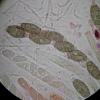
09-12-2025 12:06
 Andgelo Mombert
Andgelo Mombert
Bonjour,Je recherche l'article concernant Hypobryo

12-12-2025 18:39
Mirek GrycHello everyone.Macrofeatures similar to Mollisia b

07-12-2025 16:07
Arnold BüschlenHallo, ich habe in einer Moos-Aufsammlung (epiphy

08-12-2025 21:04
Mark Stevens"Hello everyone,I'm relatively new to microscopy (

08-12-2025 18:59
 Lothar Krieglsteiner
Lothar Krieglsteiner
.. found by a seminar-participant, I do not know t

08-12-2025 17:37
 Lothar Krieglsteiner
Lothar Krieglsteiner
20.6.25, on branch of Abies infected and thickened
I hope that anyone can help me with a tiny pyrenomycete with rather special and therefore characteristical spores. It was found on dead hanging branches of Carpinus betulus.
Description: Perithecia ovoid, flattened with a nonbeaked ostiolar opening. About 0.5 x 0.2 mm. Perithecia are immersed in small groups below the thin cortex and only the ostiolar opening is sometimes just visible. A common stroma has not been observed.
Microscopy: Asci 170-190 x 15-18 micrometer. An Apical apparatus could not be observed (not in water nor Kongo nor Iodine nor lactophenolblue). The spores are presumably muriform consisting of 8(?) cells (see photos). The apical cells are hyaline, while the inner cells are somewhat brownish with big greenish oildrops in each. Size is about 37-45 x 13-16 micrometers. Paraphyses are filiform with a diameter of only about 2 micrometers.
Any clue is very welcome.
Thank you very much
Stefan

ich denke es könnte Stilbospora macrosperma sein.
Die Sporenmasse stimmen mit deinen Angaben überein und sind 3- Fach septiert.
Was meinst du dazu? Hast du noch ein Foto vom Pilz?
Gruss Ueli Graf
Das denke ich nicht, es sei denn von Stilbospora gibt es eine Hauptfruchtform die so aussieht?? Aber Stilbospora ist ja eine Nebenfruchtform mit Konidienbildung, währenddem ich ganz klar Ascosporen habe. Zudem sind die Sporen bei mir so weit ich das beurteilen kann sowohl Längs- als auch querseptiert.
Der Pilz ist so klein, dass ich mit meinen fotografischen Möglichkeiten kaum ein aussagekräftiges Bild machen kann...
Grüsse
Stefan
Perhaps you should look towards bitunicate ascomycetes from freshwater. There are a lot of genus and some of ones have bicolor ascospores.
Alain
But is it really bitunicate ?
Your photos are excellent! I wonder if your fungus could be Fenestella bipapillata (Tul.) Sacc. A description and illustration can be found in Berlese Vol II p.76 Tab CVIII. The species probably does not represent a Fenestella in the modern sense but otherwise it seems to a good match.
M.E. Barr (Mycotaxon 18: 149-157, 1983) describes a N.Am. species, Dictyoporthe canadensis, that is similar but with smaller spores. Perhaps Fenestella bipapillata is better accomodated in Dictyoporthe.
I hope you find this information useful.
Adrian Carter
Congratulations to you, it's a nice collection.
Alain
Dictyoporthe bipapillata fits very well. Thanks for your help!

ja da habe ich auch wieder etwas gelernt bei diesem Interesanten Ascomyceten.
Gruss ueli
Thanks
Hiran
ariyawansa44@gmail.com

regards,
björn
I was searching for the type so if this tally with it hmmmm great
I look forward to hearing from you soon
Thanks
Regards
Hiran



 OestZPilz-6-0045-0049-0001.pdf
OestZPilz-6-0045-0049-0001.pdf